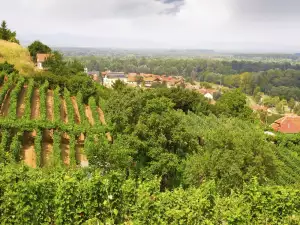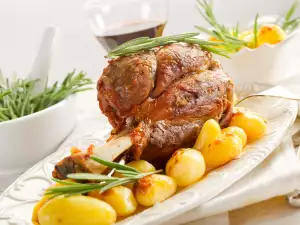Rioja is the name given to the group of high quality wines produced from varieties grown in the namesake wine region of Spain. Traditionally, these wines are red but sometimes we see white wines from Rioja as well. This famous wine region lies about 62 miles (100 km) from the shores of the Atlantic Ocean and about 186 miles (300 km) from Madrid. The climate there is soft and favorable for successful vineyard growth.
Rioja is one of the wine regions in Spain with a D.O.Ca. Qualified designation of origin. It is proof of the strict control over the naming of the wines' origin. Varieties that grow in that region and give red wines are Tempranillo and Garnacha Tinto. White wines can be obtained from Viura, Malvasia and Garnacha Blanca.
The 3 main subregions of Rioja are Rioja Alta, Rioja Alavesa and Rioja Baja. Rioja Alta is found in the western part of the region, at a higher altitude in comparison to the other subregions, explaining the later vegetative phase of the vines. The vines grown in the region give light wines, characterized by fruity aromas.
Even though Rioja Alavesa has a similar climate as Rioja Alta, the wines obtained from this subregion have a higher acidity and fuller body. The vines in the region are arranged in rows with a great distance between them. This arrangement is the result of the poor soil which is incapable of providing enough nutrients to the vines if they are densely placed.

Unlike the other 2 subregions, Rioja Baja is severely affected by the Mediterranean climate, making the area the driest and warmest corner of Rioja. During the hot summer months the temperatures rise to about 100°F (35 °C). The grapes of this region yield red wines with a high content of alcohol.
History of Rioja
The lands that are now home to the modern-day wine region have had vineyards since ancient times. Even then the Romans would use special barrels to store the gathered material. With the emergence of many religious temples in the region, winegrowing became ever more widespread.
However, the red wine of Rioja would earn serious fame much later, in the 17th century. Another century later, the first wine region association formed to protect the interests of the wine regions in Rioja. Eventually they started using wooden barrels in the wine region.
Characteristics of Rioja
Although the wines from Rioja do differ to some extent, their style can be generalized. The red wines have a fruit taste, reminding of small fruits such as strawberries and raspberries. At the same time, they have well expressed vanilla nuances, the result of the wine elixirs aging in oak barrels.
The white wines can be divided into 2 main groups. One possesses a plain taste, resulting thanks to cold fermentation. In the other, we have a wine where the temperature of fermentation is not kept low. This type of white wine is distinguished by a strong vanilla flavor. Its color is gold saturated. If both wines are mixed, the resulting wine will have a delicate vanilla charm and fruity fragrance.
Serving Rioja
Both red and white Rioja wines need to be slightly cooled before serving. The optimal temperature for the red ones is 60°F (18 °C), for the white wines - 50°F (9 °C) if they are quite young. Aged white wines can be cooled to around 50°F (12 °C). After cooling, they need to be poured into wine glasses. Red wines can be poured into a classic red wine glass, while for the white ones you can use a universal white wine glass.
The choice of glass is of prime significance when serving a quality wine, since the shape of the vessel reveals not only the saturated attractive color of the drink but also its compelling tastes and aromatic qualities. When offering our guests a glass of wine we should only fill it about halfway (or 2/3), according to etiquette. Rioja wines should also be drunk slowly in small sips. This allows the consumer to perceive the full charm of the drink.

When it comes to foods with which to combine the 2 types of Rioja wines, there is nothing too strictly specific. Simply follow the rule that a light white wine should be served at the beginning of the evening and can be combined with salads, candied fruits or desserts. You can pair it easily with a fruit salad or Belgian waffles, coconut pie and an easy cake.
Red wines from Rioja, in contrast, are served once the evening has progressed. As per tradition, they are combined with veal, beef, lamb and pork. Among the specialties you can serve with the wine are Spanish-style beef, veal ragu, Arabic kebab and pork roulades.
Certain dairy products are also a fine complement to red wines from Rioja. Chefs usually pair it with soft and delicate cheeses such as Limburger and Munster. If you have an aged grape elixir you can use Gruyere and Edammer as well.












